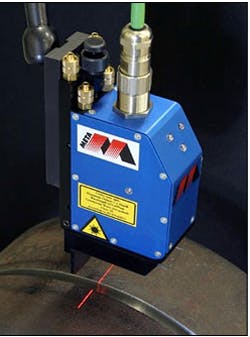Laser sensor automates arc welding
Working in collaboration with CRC-Evans Pipeline International (Houston, USA), engineers at Meta Vision Systems (Eynsham, UK) have developed a Smart Laser Sensor (SLS) for automating arc welding equipment and robot welders.
The SLS -- which consists of a CMOS megapixel image sensor with an on-board FPGA and a DSP inside the sensor head -- measures changes in the geometry and position of the pipeline joints to be welded in real time.
The data is sent via an Ethernet or CANbus interface to a motion control system driving the external welding system, ensuring that the welding electrodes are always positioned correctly.
As the SLS measures 3-D profiles, it can be used to inspect the bevel on pipe ends as well as the weld bead after it is laid.
The company claims that installing the SLS at least halves the cost of automating arc welding equipment and robot welders, compared with conventional laser sensors.
While CRC-Evans Pipeline International has worldwide exclusive rights to use the product for pipeline welding and inspection, Meta Vision Systems will be servicing demand for the sensor in all other markets.
More details on the sensor can be found here.
Recent articles on laser sensors you might also find of interest.
1. Laser-based system captures crushed cartons
Engineers at Vitronic (Wiesbaden, Germany) have developed a laser-based volume measurement system which captures the images of the surfaces of cartons and recognizes deformations.
2. Laser scanning - It's not just a flash in the pan
A manufacturer of toilets for corporate jets has used a laser scanning system from NVision (Coppell, TX, USA) to reduce tooling costs and get a new toilet design to market faster.
3. Digitizer captures 3-D images at fast data rates
Many different techniques currently exist to digitize three-dimensional objects, each of which has its own advantages. One common method uses a structured laser light that is projected across the field of view of the part to be imaged.
-- Dave Wilson, Senior Editor, Vision Systems Design
